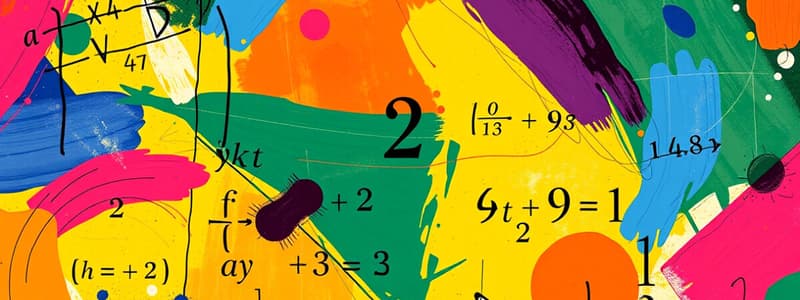Podcast
Questions and Answers
What is the value of the mathematical constant e?
What is the value of the mathematical constant e?
- 2.71828182845... (correct)
- 3.14159265359...
- 1.61803398875...
- 0.57721566490...
Define an arithmetic sequence.
Define an arithmetic sequence.
A sequence in which each term is found by adding the same number to the previous term.
What is a complex number?
What is a complex number?
A number of the form a + bi where a and b are real numbers and i is the square root of -1.
What does the degree of a polynomial refer to?
What does the degree of a polynomial refer to?
What is meant by the end behavior of a function?
What is meant by the end behavior of a function?
An even function satisfies the condition f(x) = f(-x) for all inputs of x.
An even function satisfies the condition f(x) = f(-x) for all inputs of x.
Define a geometric sequence.
Define a geometric sequence.
What is a horizontal asymptote?
What is a horizontal asymptote?
An identity equation is one that is true for all values of the variables in it.
An identity equation is one that is true for all values of the variables in it.
What is an imaginary number?
What is an imaginary number?
What is a logarithm?
What is a logarithm?
Define a logarithmic function.
Define a logarithmic function.
What is multiplicity in polynomials?
What is multiplicity in polynomials?
What is a natural logarithm?
What is a natural logarithm?
An odd function satisfies f(x) = -f(-x) for all inputs of x.
An odd function satisfies f(x) = -f(-x) for all inputs of x.
What is a polynomial function?
What is a polynomial function?
Define a rational function.
Define a rational function.
What is a real number?
What is a real number?
What is a relative maximum?
What is a relative maximum?
What is a relative minimum?
What is a relative minimum?
Define a sequence.
Define a sequence.
What is a term of a sequence?
What is a term of a sequence?
What is a vertical asymptote?
What is a vertical asymptote?
Flashcards are hidden until you start studying
Study Notes
Mathematical Constants and Sequences
- e (Mathematical Constant): An irrational number approximately equal to 2.71828182845, important in finance and science as the base for exponential functions.
- Arithmetic Sequence: A sequence where each term is obtained by adding a constant value to the previous term.
- Geometric Sequence: A sequence where each term is found by multiplying the previous term by a constant factor.
Complex Numbers and Functions
- Complex Number: A number represented as a + bi, with a and b being real numbers, and i representing the square root of -1.
- Even Function: A function f where f(x) = f(-x) for all x; characterized by symmetry around the y-axis.
- Odd Function: A function f where f(x) = -f(-x) for all x; exhibits symmetry through a 180-degree rotation about the origin.
Polynomial and Rational Functions
- Degree of a Polynomial: The highest exponent of the variable x in a polynomial expression when arranged as a sum of terms.
- Polynomial Function: A function defined by a sum of terms where each term is a constant multiplied by a whole number power of x.
- Rational Function: A function defined as a fraction of polynomials, encompassing polynomials themselves as they can be written with a denominator of 1.
Properties of Functions
- End Behavior of a Function: Describes how function outputs behave as input values become increasingly large or small, approaching specific behavior at infinity.
- Horizontal Asymptote: The line y = c indicates that functions approach the value c as inputs grow large or small, affecting the graph's behavior at extremes.
- Vertical Asymptote: The line x = a indicates points where the function is undefined and where outputs tend towards infinity as they approach a from either side.
Logarithms and Logarithmic Functions
- Logarithm: The exponent needed for a given base (e.g., base 10) to yield a particular number; the natural logarithm is denoted as ln(x).
- Logarithmic Function: Defined as f(x) = k loga(x), grows slowly and does not approach a horizontal asymptote.
Miscellaneous Definitions
- Identity Equation: An equation that holds true for all possible values of the variables.
- Imaginary Number: A number expressed as bi, where b is real, and i is defined such that i^2 = -1.
- Multiplicity: Refers to the number of times a specific factor appears in the factored form of a polynomial.
Graphical Points and Sequences
- Relative Maximum: A point on a graph that is higher than all nearby points, showcasing a peak in the function's values.
- Relative Minimum: A point on a graph that is lower than surrounding points, indicating a trough in the function's values.
- Sequence: An ordered list of numbers that can theoretically extend indefinitely, such as the series of odd positive integers.
- Term of a Sequence: Any individual number within a sequence.
Studying That Suits You
Use AI to generate personalized quizzes and flashcards to suit your learning preferences.




